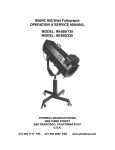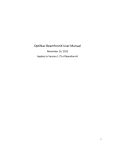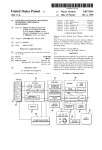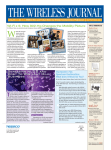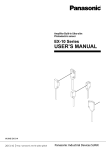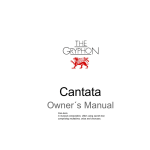Download FCC Rule Revision Walkthrough - Montana Internet Corporation
Transcript
FCC Rule Revision Walkthrough Forrest W. Christian ([email protected]) The Montana Internet Corporation Last Revised 9/8/2004 Introduction. On July 12, 2004, the FCC finally released a long-awaited Report & Order revising the Part 15 rules for the ISM bands. Many wireless internet service providers (WISPs) had eagerly awaited this rule change with the hope that it would provide some regulatory relief in certain areas including the ability to change antennas on systems at will and permit higher EIRP levels. After several months of analysis, many in the WISP community are still puzzling over the interpretation of these rules. In this document, I have attempted to walk through the portions of the rule changes which were most relevant to WISPs. It should be noted that the comments within are based on my interpretation of the rules and should not be considered official interpretation. Many in the WISP community will probably disagree with some of my specific interpretations. I look forward to many discussions on this issue in the coming months, and hopefully clarification from the FCC on the issues below. This document is intended to be a work in progress, and as such additional revisions will likely be coming as my understanding increases. Please note that in each section I have quoted below, I have attempted to include both the original text and the new text in the rules. In each of these sections, parts of the rules which have been removed from the new rule have been stricken, and the additions have been underlined and highlighted. What we are sure that the rules did not change. There were several areas which the FCC considered changing, but in the end specifically elected not to change. The main one revolved around the unique connector requirement. Many commenters to the original NPRM indicated that requiring unique connectors was ineffective and did not actually deter people from using unauthorized replacement antennas. The FCC was not convinced of this argument, and as such, all radios still must utilize unique connectors. Discussion on the Rule Changes The first section which the FCC modified which is of specific interest to WISPs is related to power amplifiers and replacement antennas: § 15.204 External radio frequency power amplifiers and antenna modifications. (a) Except as otherwise described in paragraph (b) and (d) of this section, no person shall use, manufacture, sell or lease, offer for sale or lease (including advertising for sale or lease), or import, ship, or distribute for the purpose of selling or leasing, any external radio frequency power amplifier or amplifier kit intended for use with a Part 15 intentional radiator. The only revision to paragraph (a) was to add a reference to paragraph (d) which is below. (b) A transmission system consisting of an intentional radiator, an external radio frequency power amplifier, and an antenna, may be authorized, marketed and used under this part. However, Except as described otherwise in this section, when a transmission system is authorized as a system, it must always be marketed as a complete system and must always be used in the configuration in which it was authorized. An external radio frequency power amplifier shall be marketed only in the system configuration with which the amplifier is authorized and shall not be marketed as a separate product. Paragraph (b) was revised to permit amplifiers to be marketed, as described later, as a separate item. However, as we will see later, this does not mean that you can just buy (or sell) an amplifier to use with any system without limitation. Note that selling a complete system with a radio, amplifier and antenna is still perfectly legal. (c) Only the antenna with which an intentional radiator is authorized may be used with the intentional radiator. An intentional radiator may be operated only with the antenna with which it is authorized. If an antenna is marketed with the intentional radiator, it shall be of a type which is authorized with the intentional radiator. An intentional radiator may be authorized with multiple antenna types. (1) The antenna type, as used in this paragraph, refers to antennas that have similar in-band and out-of-band radiation patterns. (2) Compliance testing shall be performed using the highest gain antenna for each type of antenna to be certified with the intentional radiator. During this testing, the intentional radiator shall be operated at its maximum available output power level. (3) Manufacturers shall supply a list of acceptable antenna types with the application for equipment authorization of the intentional radiator. (4) Any antenna that is of the same type and of equal or less directional gain as an antenna that is authorized with the intentional radiator may be marketed with, and used with, that intentional radiator. No retesting of this system configuration is required. The marketing or use of a system configuration that employs an antenna of a different type, or that operates at a higher gain, than the antenna authorized with the intentional radiator is not permitted unless the procedures specified in Section 2.1043 of this chapter are followed. The above set of paragraphs deals solely with antennas. Many WISPs seem to feel that this section only applies if an amplifier is in use. I can't seem to find any evidence that this is the case, and nothing within this paragraph indicates this. Under the new rules, paragraph (c) was amended to require manufacturers to only test a single antenna of a given type with their radios. The FCC has defined "type" to mean an antenna with similar in and out of band radiation patterns. This should help manufacturers give customers more antenna options due to the fact that manufacturers now only need to do one expensive certification test for any given type of antenna. Many WISPs believe that this section now means that they (the WISP, not the manufacturer) can use any antenna of a "similar type" to what the manufacturer used to certify the device. For example, if the manufacturer certified their system with a 12dbi flat panel antenna from manufacturer A, they can now use any flat panel antenna of 12dbi or lower from any manufacturer. I am not convinced that this is the case. Three specific items concern me with this interpretation. First, paragraph (3) above, requires the manufacturer supply a list of acceptable similar antenna types. Second, in the commentary in the report and order, the FCC said that "The manufacturer must supply a list of other acceptable antennas in the literature delivered to the customer." Finally, in many cases, antennas which seem similar mechanically (and even with similar in-band antenna patterns) behave very differently in the presence of RF, and especially in their out-of-band patterns. I would welcome some official clarification from the FCC in regards to this issue. (d) Except as described in this paragraph, an external radio frequency power amplifier or amplifier kit shall be marketed only with the system configuration with which it was approved and not as a separate product. (1) An external radio frequency power amplifier may be marketed for individual sale provided it is intended for use in conjunction with a transmitter that operates in the 902 – 928 MHz, 2400 – 2483.5 MHz, and 5725 – 5850 MHz bands pursuant to § 15.247 of this part or a transmitter that operates in the 5.725 – 5.825 GHz band pursuant to § 15.407 of this part. The amplifier must be of a design such that it can only be connected as part of a system in which it has been previously authorized. (The use of a non-standard connector or a form of electronic system identification is acceptable.) The output power of such an amplifier must not exceed the maximum permitted output power of its associated transmitter. (2) The outside packaging and user manual for external radio frequency power amplifiers sold in accordance with paragraph (d)(1) must include notification that the amplifier can be used only in a system which it has obtained authorization. Such a notice must identify the authorized system by FCC Identifier. Paragraph (d) has been added to permit manufacturers to build, certify, and sell amplifiers which can be sold separately. The intention appears to require amplifier manufacturers to certify their amplifiers with specific radios and antennas, and market them only for use with those radios and antennas. Note that this specifically indicates that an amplifier must be authorized in a system. That is, with a specific radio and antenna. Buying any random amplifier and connecting it to a radio and or antenna it isn't certified with isn't permitted under the rules. § 15.247 Operation within the bands 902-928 MHz, 2400-2483.5 MHz, and 5725-5850 MHz. Section 15.247 describes power limits in the ISM bands at 900Mhz, 2.4Ghz and 5.8Ghz. For brevity and clarity, I have removed any Paragraphs related only to Frequency Hopping Spread Spectrum, and have concentrated on Direct Sequence only. (a) Operation under the provisions of this Section is limited to frequency hopping and digitally modulated intentional radiators that comply with the following provisions: ... (2) Systems using digital modulation techniques may operate in the 902 - 928 MHz, 2400 - 2483.5 MHz, and 5725 - 5850 MHz bands. The minimum 6 dB bandwidth shall be at least 500 kHz. (b) The maximum peak conducted output power of the intentional radiator shall not exceed the following: ... (3) For systems using digital modulation in the 902-928 MHz, 2400-2483.5 MHz, and 5725-5850 MHz bands: 1 Watt. As an alternative to a peak power measurement, compliance with the one Watt limit can be based on a measurement of the maximum conducted output power. Maximum Conducted Output Power is defined as the total transmit power delivered to all antennas and antenna elements averaged across all symbols in the signaling alphabet when the transmitter is operating at its maximum power control level. Power must be summed across all antennas and antenna elements. The average must not include any time intervals during which the transmitter is off or is transmitting at a reduced power level. If multiple modes of operation are possible (e.g., alternative modulation methods), the maximum conducted output power is the highest total transmit power occurring in any mode. (4) The conducted output power limit specified in paragraph (b) of this section is based on the use of antennas with directional gains that do not exceed 6 dBi. Except as shown in paragraphs (b)(3) (i), (ii) and (iii) (c) of this section, if transmitting antennas of directional gain greater than 6 dBi are used, the peak conducted output power from the intentional radiator shall be reduced below the stated values in paragraphs (b)(1), or (b)(2), and (b)(3) of this section, as appropriate, by the amount in dB that the directional gain of the antenna exceeds 6 dBi. The changes above are related to a subtle change between just using peak power and using conducted output power. I don't pretend to completely understand this, other than to state that my understanding is that certain modulation schemes are penalized by using peak power instead of the conducted output power. Regardless, this section still provides our standard maximum output power point. 1 Watt into a 6dbi antenna, or 30dBm+6dbi=36dBm EIRP. I usually call this rule the "point to multipoint limit". Without specific exemptions, every ISM band transmitter is required to be below this limit. The next few sections provide exceptions to this limit. They are as follows: (c) Operation with directional antenna gains greater than 6 dBi. (1) Fixed point-to-point operation: (i) Systems operating in the 2400-2483.5 MHz band that are used exclusively for fixed, point-to-point operations may employ transmitting antennas with directional gain greater than 6 dBi provided the maximum conducted output power of the intentional radiator is reduced by 1 dB for every 3 dB that the directional gain of the antenna exceeds 6 dBi. (ii) Systems operating in the 5725-5850 MHz band that are used exclusively for fixed, point-to-point operations may employ transmitting antennas with directional gain greater than 6 dBi without any corresponding reduction in transmitter conducted output power. (iii) Fixed, point-to-point operation, as used in paragraphs (b)(3)(c)(4)(i) and (b) (3)(c)(4)(ii) of this section, excludes the use of point-to-multipoint systems, omnidirectional applications, and multiple co-located intentional radiators transmitting the same information. The operator of the spread spectrum or digitally modulated intentional radiator or, if the equipment is professionally installed, the installer is responsible for ensuring that the system is used exclusively for fixed, point-to-point operations. The instruction manual furnished with the intentional radiator shall contain language in the installation instructions informing the operator and the installer of this responsibility. The above 3 paragraphs, which have not changed, other than their numbering, permit point-topoint operations at a higher EIRP. Specifically, in 2.4Ghz, for each 3 dbi of antenna gain you have above the "base" 6dbi of gain permitted above, you have to reduce the transmitter power by 1 db. For example a point to point link utilizing 24dbi Grids can have a permissible real output power of 30dBm-(18/3)=24dBm. Adding the 24dbi of antenna gain back in, you come up with a figure of 48dBm (64 Watts) of EIRP. This is usually considered about the maximum practical power for 2.4Ghz, primarily because very few people want 4' dishes hanging around. Historically, the FCC has informally indicated that they consider any radio which is talking to one and only one other radio to be under the point-to-point (3 for 1) rule, and any radio which talks to more than one radio to be under the point-to-multipoint (36dBm EIRP max) rule. This means that customer endpoints are considered point-to-point, and access points are considered point-to-multipoint. Prior to the new rules, this was the only exception to the 36dBm EIRP rule. The new rules have added another "advanced antenna system" exception, which is described below. The actual interpretation of these rules have not been clarified by the FCC as of 9/8/2004. The following is intended to provide the author's interpretation of this new rule set. (2) In addition to the provisions in paragraphs (b)(1), (b)(3), (b)(4) and (c)(1)(i) of this section, transmitters operating in the 2400-2483.5 MHz band that emit multiple directional beams, simultaneously or sequentially, for the purpose of directing signals to individual receivers or to groups of receivers provided the emissions comply with the following: First thing to note is that this only applies to 2.4Ghz, not 900Mhz or 5.8Ghz. (i) Different information must be transmitted to each receiver. I find this requirement interesting. It would appear, on it's face, to eliminate any radio implementation which intentionally broadcasts the same data simultaneously to multiple receivers. Standard 802.11b into a sectoral antenna would definitely not fit into this category since it uses beacons and by definition broadcasts ARP, etc. Some sort of polled (or round robin) system apparently would be necessary to be permitted. I.E. transmit to endpoint 1, transmit to endpoint 2, transmit to endpoint 3, and then back to endpoint 1. Without internal knowledge of existing 2.4Ghz polling systems, I would be hard pressed to say that any existing system (e.g. Karlnet) would fit this requirement. With that in mind, it isn't a stretch of the imagination that existing 2.4Ghz equipment, with no hardware changes whatsoever, could be fixed in firmware to operate in this manner. However, doing so would actually increase the interference potential of a system. I believe the FCC is trying to require the systems to work in a similar way to the vivato system. That is, form a directional beam towards a client, transmit to the client, and then reform the beam towards the next client and repeat. (ii) If the transmitter employs an antenna system that emits multiple directional beams but does not do emit multiple directional beams simultaneously, the total output power conducted to the array or arrays that comprise the device, i.e., the sum of the power supplied to all antennas, antenna elements, staves, etc. and summed across all carriers or frequency channels, shall not exceed the limit specified in paragraph (b)(1) or (b)(3) of this section, as applicable. However, the total conducted output power shall be reduced by 1 dB below the specified limits for each 3 dB that the directional gain of the antenna/antenna array exceeds 6 dBi. The directional antenna gain shall be computed as follows: (A) The directional gain shall be calculated as the sum of 10 log (number of array elements or staves) plus the directional gain of the element or stave having the highest gain. (B) A lower value for the directional gain than that calculated in paragraph (c) (2)(ii)(A) of this section will be accepted if sufficient evidence is presented, e.g., due to shading of the array or coherence loss in the beamforming. This is describing a Vivato-like system exactly. Form a beam, transmit, repeat. Note that paragraph (ii) actually describes the "3-for-1" point to point rule. Note that I interpreted the first sentence to say "but does not emit" instead of the FCC's mangled english of "does not do emit". I interpret this section to mean that if you build a system which forms a beam to a single station, transmits to the station, then forms a beam to the next station and repeats, then this is permitted under the rules, and you can transmit at the point-to-point (3-for-1) power level. In addition to the beamforming system, I could also envision a system built with a single transmitter attached to some sort of fast antenna switch which is then attached to an array of narrowbeam antennas. The system would pick the strongest antenna for the client, switch to that antenna, transmit, and then repeat. Note that a polled system would most certainly be required for this to work. Whether the FCC would certify this or not would be an entertaining point of conversation with the FCC. (iii) If a transmitter employs an antenna that operates simultaneously on multiple directional beams using the same or different frequency channels, the power supplied to each emission beam is subject to the power limit specified in paragraph (c)(2)(ii) of this section. If transmitted beams overlap, the power shall be reduced to ensure that their aggregate power does not exceed the limit specified in paragraph (c)(2)(ii) of this section. In addition, the aggregate power transmitted simultaneously on all beams shall not exceed the limit specified in paragraph (c)(2)(ii) of this section by more than 8 dB. In the context of paragraph (ii), paragraph (iii) seems fairly clear. All paragraph (iii) appears to be describing is an enhanced version of a paragraph (ii) system which is capable of transmitting on multiple beams simultaneously. This paragraph adds two additional requirements to this type of system. The first is that you can't exceed the point-to-point EIRP limits in any direction, even if you need to form two beams in the same direction. If you do transmit multiple beams in the same direction, you have to reduce your power such that the limits aren't exceeded. The second is the 8db limit. This essentially limits a system to being able to put out 6 fullpowered beams at once (in different directions). Because of the way the rule is written, it is conceivable that a system could be set up to form more than the 6 beams at once and trade EIRP for number of beams (or in other words, reduce power and increase the number of beams). (iv) Transmitters that emit a single directional beam shall operate under the provisions of paragraph (c)(1) of this section. Paragraph (iv) basically closes a loophole which may have existed for systems which talk to only one endpoint at once (see my comments under (i), above). You can't take a polled system and put a sectoral antenna on it and be permitted under the rules. You have to have some sort of more advanced antenna system. I.E. something which beamforms or similar. The remainder of this section deals with out of band limits and power spectral density limits, which aren't all that interesting to WISPs, so I have omitted them. Summary. Although the FCC's rule changes were expected to make significant changes which would benefit WISPs, it seems that the rule changes actually do very little. Specifically: 1) The rules appear to not permit WISP's to change antennas at will. The rules do appear to make it easier and less expensive for manufacturers to authorize additional antennas for use with their systems, but the responsibility still appears to be with the manufacturer to authorize the antennas. 2) Although the FCC said in their Report & Order that they were wanting to permit sectoral antennas under the point-to-point rules, no traditional point-to-multipoint sectoral system appears to be able to comply with the new rules. Instead, a system must do some sort of dynamic beamforming (or direct beams in a given direction in some other sort of dynamic way), and must talk to a single station at a time. Or, put a different way, beamform, transmit, repeat. I would love to be wrong in both of these cases. It would make my life as a WISP a lot easier in some cases. Unfortunately, I'm not convinced that I am. If someone from the FCC would like to further clarify any of the above issues, I would love to hear from them.







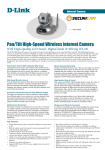
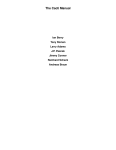


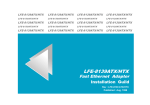
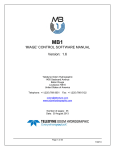
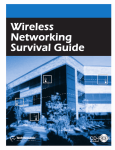
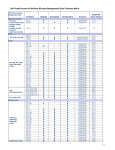
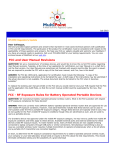
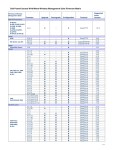
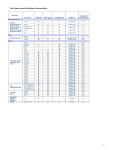

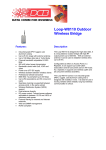
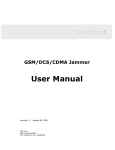
![[4910-13-U] DEPARTMENT OF TRANSPORTATION Federal](http://vs1.manualzilla.com/store/data/005730800_1-83b69f38eee92750e4a30066087ffbc6-150x150.png)
